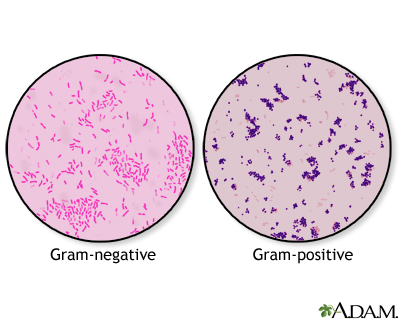Gram stain of urethral discharge
Urethral discharge Gram stain; Urethritis - Gram stain
A Gram stain of urethral discharge is a test used to identify bacteria in fluid from the tube that drains urine from the bladder (urethra).
Images


I Would Like to Learn About:
How the Test is Performed
Fluid from the urethra is collected on a cotton swab. A sample from this swab is applied in a very thin layer to a microscope slide. A series of stains called a Gram stain is applied to the specimen.
The stained smear is then examined under the microscope for the presence of bacteria. The color, size, and shape of the cells help identify the type of bacteria causing the infection.
How to Prepare for the Test
This test is often performed in the health care provider's office.
How the Test will Feel
You may feel pressure or burning when the cotton swab touches the urethra.
Why the Test is Performed
The test is performed when an abnormal urethral discharge is present. It may be performed if a sexually transmitted infection is suspected.
Normal Results
Normal value ranges may vary slightly among different laboratories. Some labs use different measurements or test different samples. Talk to your provider about the meaning of your specific test results.
What Abnormal Results Mean
Abnormal results may indicate gonorrhea or other infections.
Risks
There are no risks.
Considerations
A culture of the specimen (urethral discharge culture) should be performed in addition to the Gram stain. More advanced tests (such as PCR tests) may also be done.
References
Babu TM, Urban MA, Augenbraun MH. Urethritis. In: Bennett JE, Dolin R, Blaser MJ, eds. Mandell, Douglas, and Bennett's Principles and Practice of Infectious Diseases. 9th ed. Philadelphia, PA: Elsevier; 2020:chap 107.
Swygard H, Cohen MS. Approach to the patient with a sexually transmitted infection. In: Goldman L, Schafer AI, eds. Goldman-Cecil Medicine. 26th ed. Philadelphia, PA: Elsevier; 2020:chap 269.
BACK TO TOPReview Date: 10/20/2022
Reviewed By: Linda J. Vorvick, MD, Clinical Professor, Department of Family Medicine, UW Medicine, School of Medicine, University of Washington, Seattle, WA. Also reviewed by David C. Dugdale, MD, Medical Director, Brenda Conaway, Editorial Director, and the A.D.A.M. Editorial team.

Health Content Provider
06/01/2025
|
A.D.A.M., Inc. is accredited by URAC, for Health Content Provider (www.urac.org). URAC's accreditation program is an independent audit to verify that A.D.A.M. follows rigorous standards of quality and accountability. A.D.A.M. is among the first to achieve this important distinction for online health information and services. Learn more about A.D.A.M.'s editorial policy, editorial process and privacy policy. A.D.A.M. is also a founding member of Hi-Ethics. This site complied with the HONcode standard for trustworthy health information from 1995 to 2022, after which HON (Health On the Net, a not-for-profit organization that promoted transparent and reliable health information online) was discontinued. |
The information provided herein should not be used during any medical emergency or for the diagnosis or treatment of any medical condition. A licensed medical professional should be consulted for diagnosis and treatment of any and all medical conditions. Links to other sites are provided for information only -- they do not constitute endorsements of those other sites. © 1997- 2024 A.D.A.M., a business unit of Ebix, Inc. Any duplication or distribution of the information contained herein is strictly prohibited.
